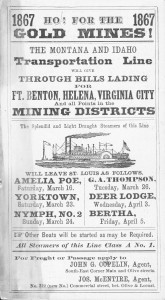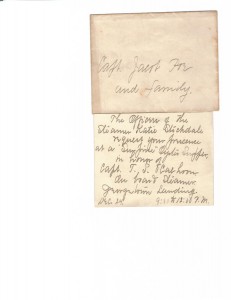In 1866, the str Amelia Poe commanded by Capt Thomas W Poe was the first boat from Georgetown to venture to Ft Benton in the Montana Territory. Thomas S Calhoon was the 1st clerk. The log of his trip up the Missouri River to Ft Benton in the Montana Territory has been loaded on the page TS Calhoon’s Book 1866.
This Missouri River adventure was transcribed from a copy of a copy of “Thomas S Calhoon’s Book 1866” [1] The original journal I have not seen, nor know where it is. The Heinz History Center research library has a typed copy which I assume was transcribed from the original by Harriet (Calhoon) Ewing. I have attempted to stay true to the copy. It presents some challenges: There is no punctuation; spelling is phonetic such as Schiann for Cheyenne, kild for killed, etc. Still it is full of swash and buckle.
Of the 51 boats that departed St Louis that season, 32 docked at Ft Benton. Millions of dollars of gold from the mines flowed down the “Golden Highway”. It was impossible to estimate the amount of gold because it flowed down the Missouri in pockets, in chests, in a buck wagon, and as payment for freight delivered. Freight that year was bringing 10-12 cents per pound; steamboat passage from St Louis was $150-200. While a barrel of salt was $1.25 in St Louis, it brought $45 in Helena. The total freight up was 6,644 tons and passengers up was 502. [2]
Arriving on 11 Jun 1866, the Amelia Poe delivered 200 tons of freight and 40 passengers. Downward gold and passengers was not recorded.


